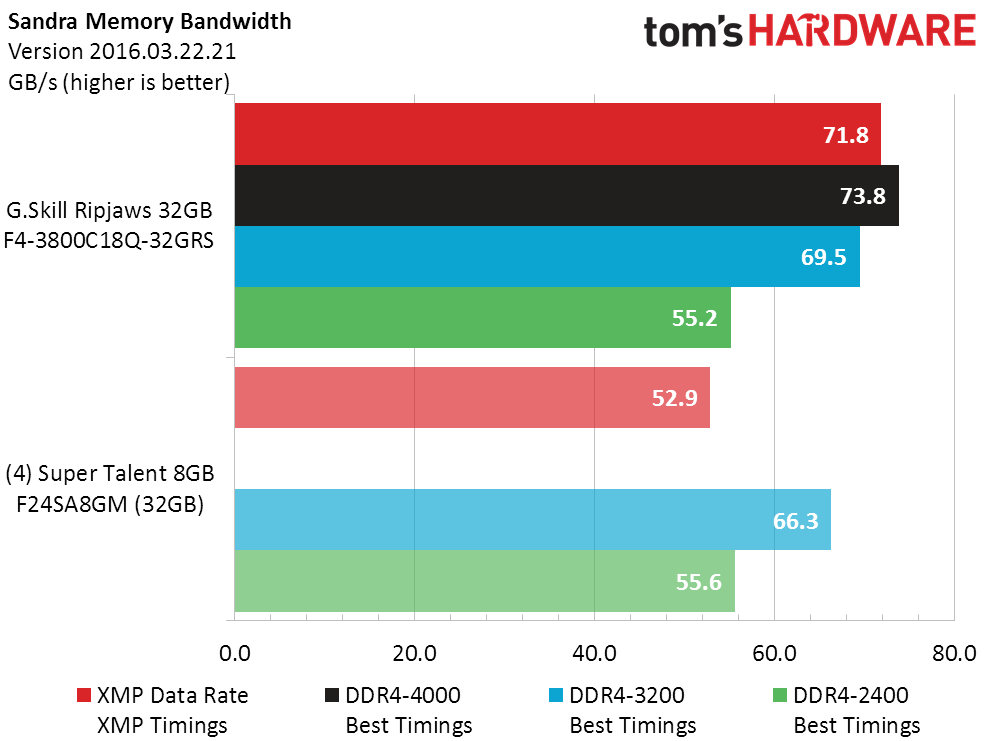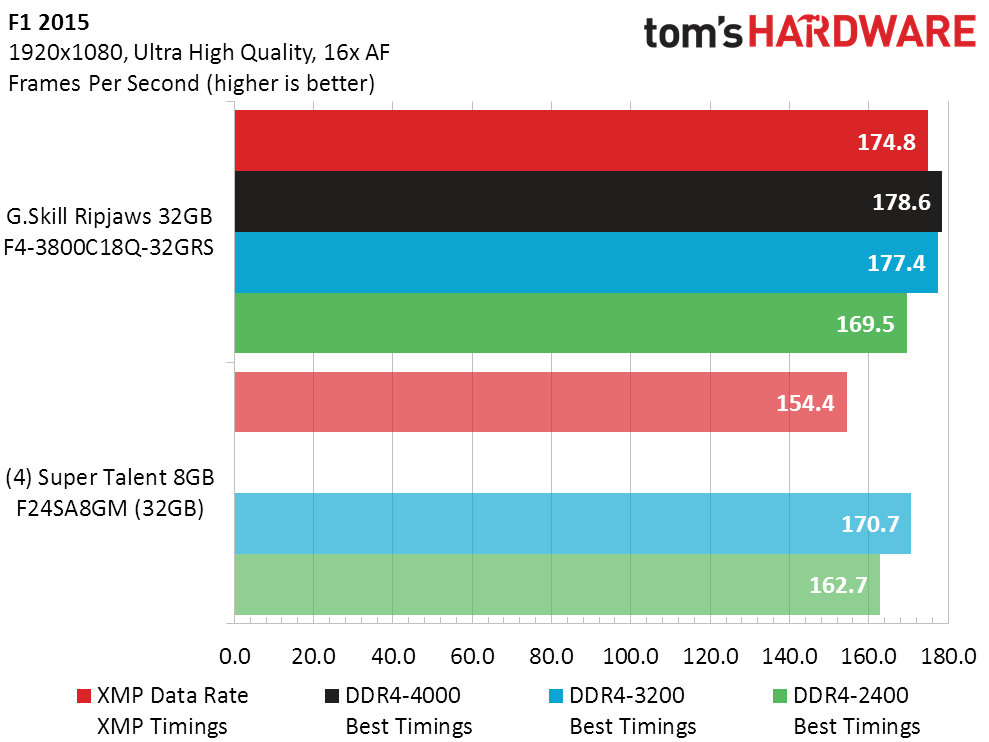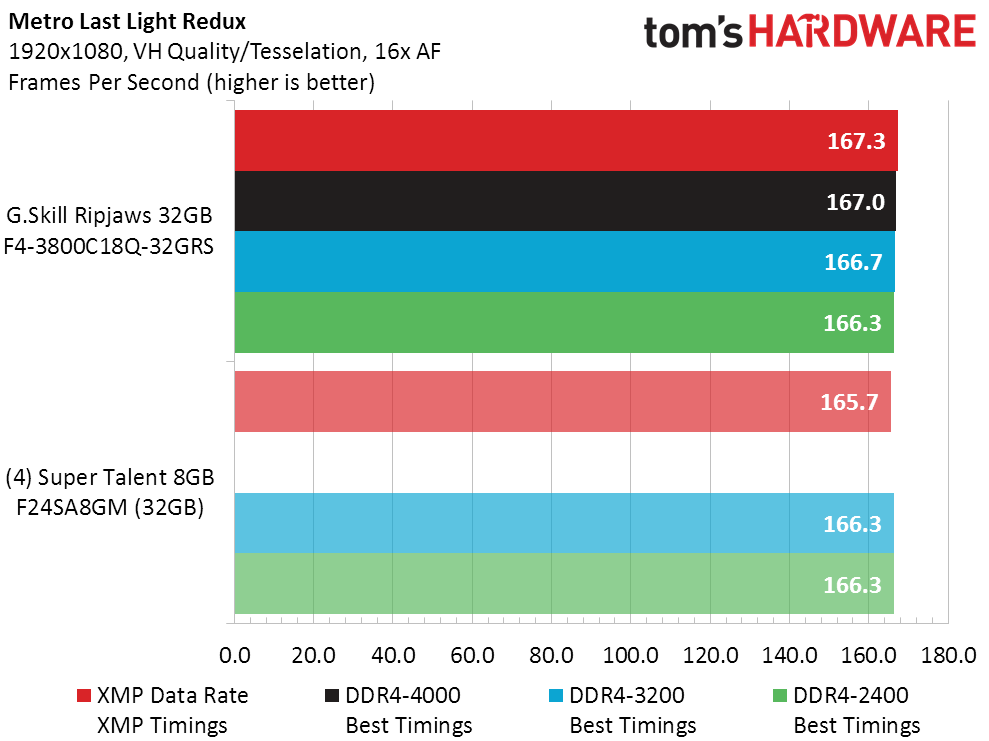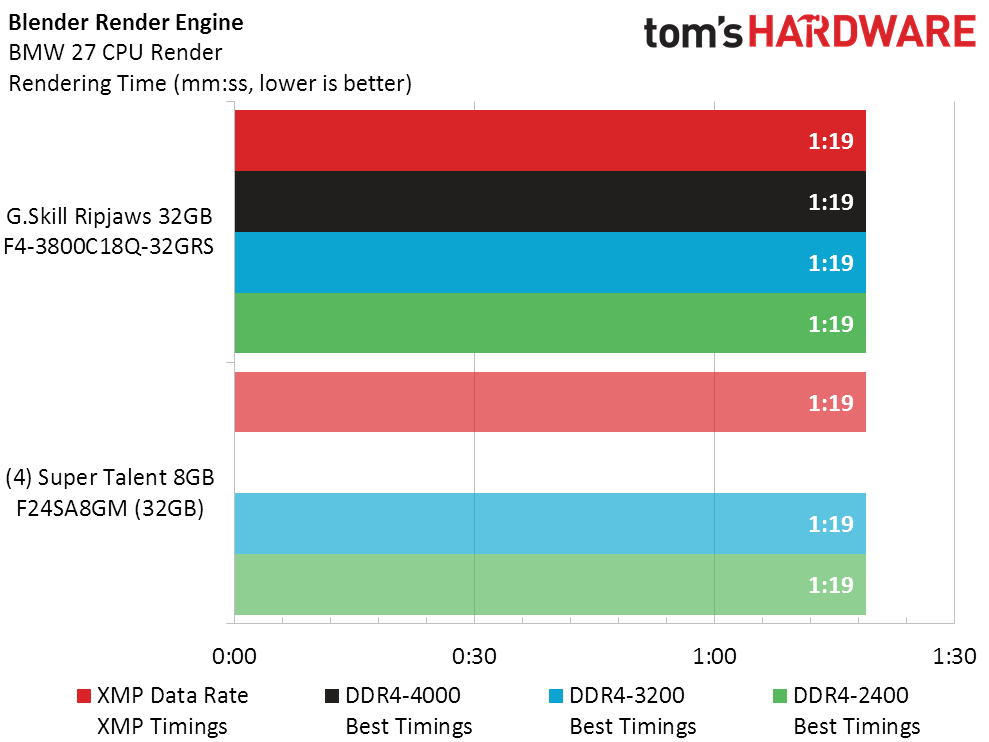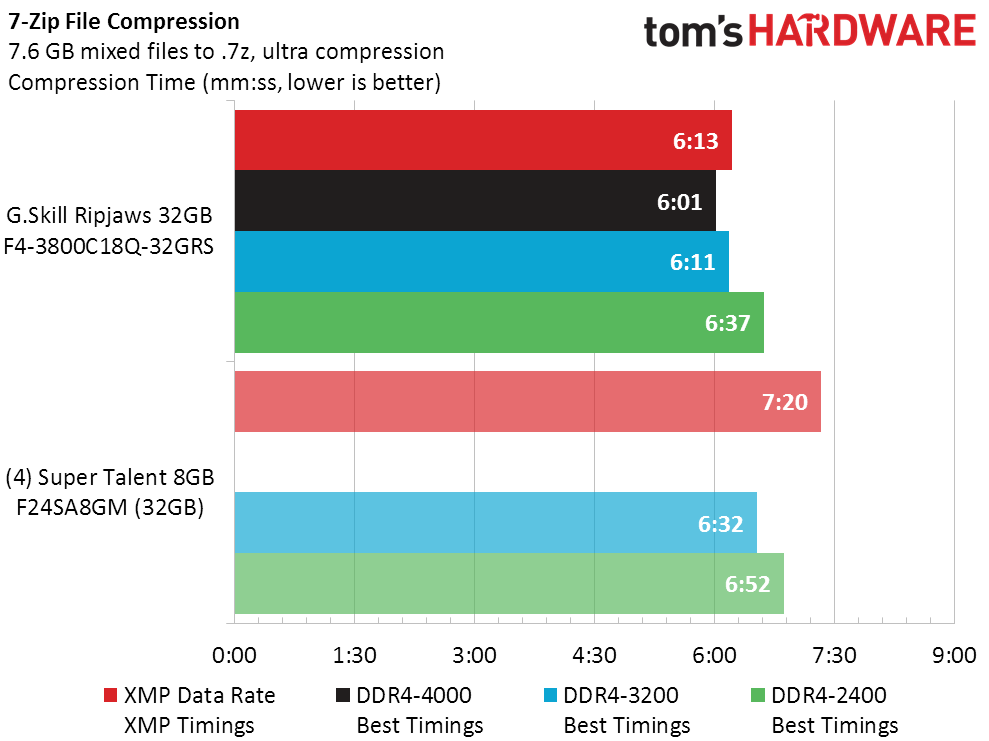G.Skill DDR4-3800 32GB SODIMM Review
Why you can trust Tom's Hardware
Benchmark Results & Final Analysis
We shouldn’t be surprised that the Ripjaws DDR4-3800 reached DDR4-4000 simply by loosening the timings, but we’re a little surprised that it also reached DDR4-2400 at a mere CAS 11. Also, is anyone noticing the 33% overclock achieved on Super Talent’s CAS 17-rated DDR4-2400? Amazing.
| Lowest Stable Timings at 1.35V (Max) on ASRock X299E-ITX/ac (BIOS 1.03) | |||
| DDR4-4000 | DDR4-3200 | DDR4-2400 | |
| G.Skill Ripjaws 32GBF4-3800C18Q-32GRS | 19-19-19-38 (2T) | 14-14-14-28 (1T) | 11-11-11-28 (1T) |
| (4) Super Talent 8GB F24SA8GM (32GB) | X | 17-19-19-38 (1T) | 13-14-14-28 (1T) |
So, how far will these modules go? We first had to determine what the maximum settings should be. Our CPU has to last through the entire X299 review series, so excessive voltage wasn’t even on the table. Yet DDR4-4800 is on the horizon, and following the trend of DDR2-800 CAS 4, DDR3-1600 CAS 8, and DDR4-3200 CAS 16, we picked CAS 24. Unfortunately, most boards don’t work well past CAS 19, so the compromise of 19-24-24-48 timings was chosen as the limit.
We tried for DDR4-4200, but the setting wouldn’t even boot. Perhaps that’s due to the high 21x multiplier? The next higher setting of DDR4-4266 uses a lower 16x multiplier thanks to the CPU’s available 4:3 memory controller BCLK to core BCLK ratio, yet it also wouldn’t boot. Without spending days trying to configure advanced settings, DDR4-4160 was still a reasonable limit. And not to be outdone as a value-priced overclocking option, the DDR4-2400 samples reached DDR4-3328.
Ripjaws DDR4-3800 tears though Sandra’s Bandwidth bench, annihilating the rated settings of the DDR4-2400. For value-seeking overclockers, custom tweaks bring the lower cost memory’s loss up to acceptable levels.
Lower is better regarding latency, and the Ripjaws rips through Sandra’s test there as well. On the other hand, custom timings again take the embarrassment out of the lower cost Super Talent memory’s results.
F1 2015 is famed for its bandwidth dependence, or its CPU dependence, or its timing dependence, depending on which weakness is the greatest. With a 4.40 GHz CPU clock, the game shows big advantages for performance memory settings compared to the stock DDR4-2400 results. Once again though, we still see that custom tuning can push the lower cost configuration up to nearly competitive performance.
Metro Last Light’s reaction to changes in memory settings is closer to the typical reaction we see in most games, and we’ve included it just to remind users that fast DRAM isn’t a panacea. Slow RAM has previously pulled the bench down, but we generally don’t touch anything below mainstream.
Get Tom's Hardware's best news and in-depth reviews, straight to your inbox.
Blender is also a type of application that’s harmed by slow RAM, but reaches a plateau somewhere around mainstream level. The chart doesn’t show that the actual performance range was 78.6 to 79.4 seconds, but we saw it in the results text, which only showed us that the performance differences were electronically measurable but imperceptible.
7-Zip loves fast RAM. The Ripjaws DDR4-3800 started out strong and got stronger with a bit of tuning. Tuning helped the cheap set more because it started out so poorly at stock settings.
Ripjaws DDR4-3800 started out around 8% stronger than the baseline DDR4-2400 across the average of real-world benchmarks, but it also costs around 50% more. This would have looked much better had we compared it against the price of an entire PC, since it accelerates applications for the entire PC. Adding $2000 to the price of each kit would have made the black bars for both kits reach 100%, allowing one to honestly say that if the rest of the PC costs more than $2000, the Ripjaws DDR4-3800 could be the better deal at stock rated settings. Memory tuners, on the other hand, could point out that the blue bars don’t reach the same value parity unless the rest of the machine costs $4800.
Beyond the classic calculations of value are the concepts of risk and bestness. One doesn’t need to spend $4800 on their machine to want the “best” RAM, just as many users buy a top-model processor when the next one down would have sufficed. And there’s always the risk of not reaching performance goals for those who decide to start with a lower cost product and overclock. We give the product a nod for those who refuse to settle for less.
MORE: Best Memory
MORE: DDR DRAM FAQs And Troubleshooting Guide
MORE: All Memory Content
-
WyomingKnott At six times the price, I personally wouldn't think that the improvement is worth it. Are those prices correct?Reply -
Crashman Reply
That's the price of ONE STICK of the cheaper RAM, because the cheaper RAM is sold in single sticks.20613165 said:At six times the price, I personally wouldn't think that the improvement is worth it. Are those prices correct? -
Crashman Reply
So you say you want DDR4-3800 to be cheaper than DDR4-2400? Great, LMK where you found that $24k supercar and then WE'LL talk :D20613567 said:Drop the price by about $375 and then we'll talk.
-
BulkZerker ReplySo you say you want DDR4-3800 to be cheaper than DDR4-2400? Great, LMK where you found that $24k supercar and then WE'LL talk :D
Last time I bought 32 gigs of 2400 it was $110 so yeah. Thats kinda the point. -
Crashman Reply
You're talking about long DIMMs or year-old prices? That 2400 price shown is for ONE 8GB module. 8GB. Not 32GB. There was a price run-up throughout 2017.20614626 said:So you say you want DDR4-3800 to be cheaper than DDR4-2400? Great, LMK where you found that $24k supercar and then WE'LL talk :D
Last time I bought 32 gigs of 2400 it was $110 so yeah. Thats kinda the point.
-
richardgraham651 Must be one of the most badly written articles ever on Tom's Hardware. The total balls up with the price comparison is bad enough but the entire article is just thrown together, badly written and pretty much useless.Reply
Probably had to meet the deadline by the editor but was still in a jumbled mess from a long night on the piss.
Crap article - Not the usual standard here. -
Crashman Reply
The proper prices were used in the charts. Regarding the problem of a single-module DDR4-2400 price being shown in the shopping link, I can't fix the internet.20615815 said:Must be one of the most badly written articles ever on Tom's Hardware. The total balls up with the price comparison is bad enough but the entire article is just thrown together, badly written and pretty much useless.
Probably had to meet the deadline by the editor but was still in a jumbled mess from a long night on the piss.
Crap article - Not the usual standard here.
-
lsatenstein Its ridiculous that Dimms are priced at more then the CPU. Greed hath no limit. Look at the worlds population makeup. Most of the adults were born post war, between 1945 and 1950. We 70 year old boomers don't have the money to spend on hardware that is triple overpriced. Its time that gpu and ddr manufacturers wake up to the fact that seniors are not buying new systems, and the reason is that the new systems are priced way to high. Give me 32Gigs of 2800 mhz ddr4 for $100, and bring the gpu items down to $200, and manufacturers will find reams of senior aged customers that will upgrade their systems.Reply
Our flat panel TV uses as much ram as a gpu. The flatpanel TV costs substantially less than any laptop or desktop that has comparable compute power. That's my argument as to what is wrong with hardware today. -
Crashman Reply
There was a run on DRAM last year in the futures market due to predictions of tight supply. While you may not get your 32GB for $100 in the near future, I wouldn't be surprised if current pricing was halved. I'd be less surprised if it went down 30% and went back up 20% from that point though, due to speculation manipulating prices.20618003 said:Its ridiculous that Dimms are priced at more then the CPU. Greed hath no limit. Look at the worlds population makeup. Most of the adults were born post war, between 1945 and 1950. We 70 year old boomers don't have the money to spend on hardware that is triple overpriced. Its time that gpu and ddr manufacturers wake up to the fact that seniors are not buying new systems, and the reason is that the new systems are priced way to high. Give me 32Gigs of 2800 mhz ddr4 for $100, and bring the gpu items down to $200, and manufacturers will find reams of senior aged customers that will upgrade their systems.
Our flat panel TV uses as much ram as a gpu. The flatpanel TV costs substantially less than any laptop or desktop that has comparable compute power. That's my argument as to what is wrong with hardware today.

